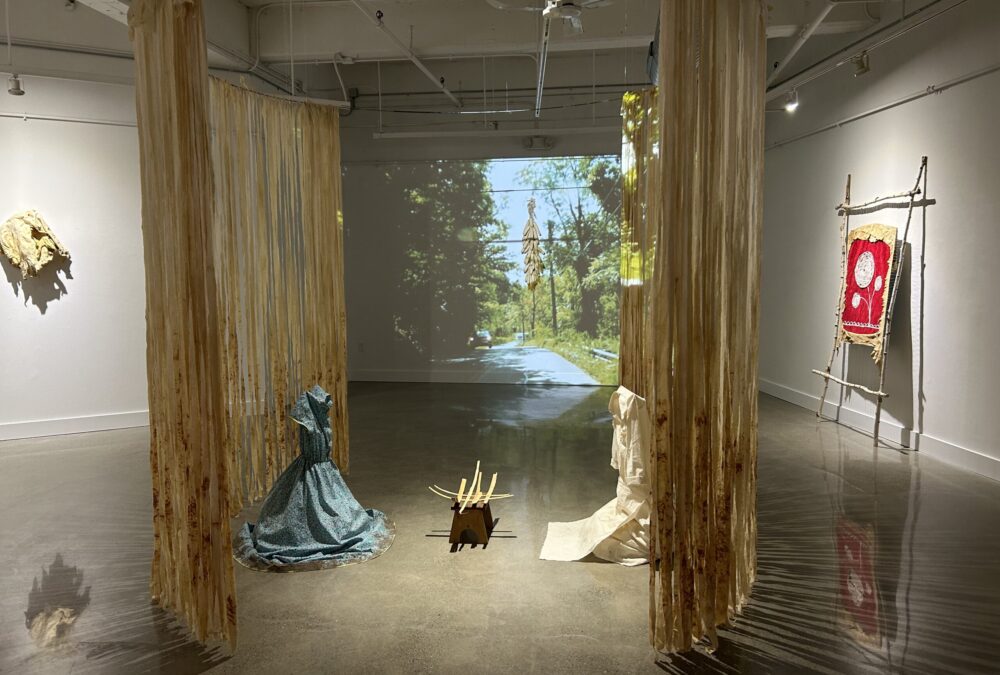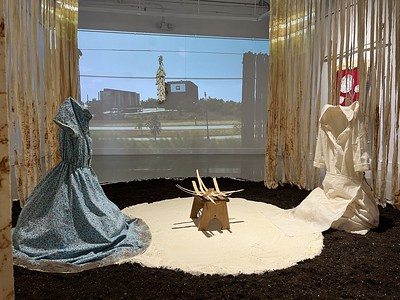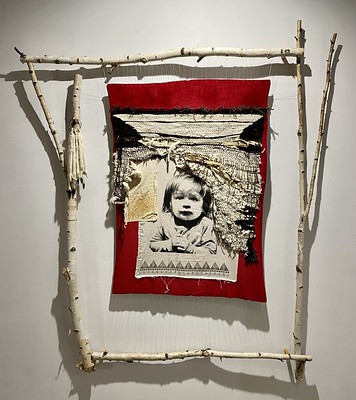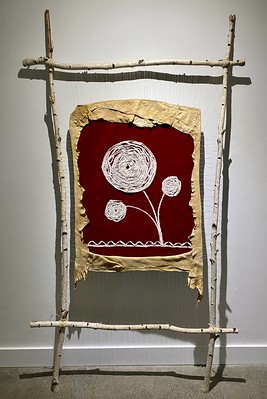Date/Time
Date(s) - 01/27/2023 - 03/01/2023
12:00 am
Location
Buffalo Arts Studio
Categories
Opening Reception, Friday, January 27, 2023, 5:00—8:00 pm
Part of M&T Bank 4th Friday @ Tri-Main Center
Where the Rust Meets the Land
Jodi Lynn Maracle is a Kanien’keha:ka mother, artist, craftswoman, and scholar-activist. She centers her work on reclaiming space and memory in the face of settler-colonial occupation through contemporary representations of Indigenous cultural legacies and lived realities. She blends traditional Haudenosaunee skills, symbols, forms, and language with modern forms of making to articulate historical and contemporary relationships to place, land, and community.
Where the Rust Meets the Land is an ambitious installation with much of the sculptural work assembled on site. What follows is a transcript from a series of conversations between Jodi Lynn Maracle and Curator Shirley Verrico as they worked on this project, as well as Maracle’s Artist Introduction on opening night of the exhibition.
VERRICO: Okay Jodi, we’re putting a lot of the work together on-site. You are on a stepstool, carefully sewing this textile to its birch supports. Can you tell me a little bit about this piece?
MARACLE: This piece I am working on is called Caroline Parker Didn’t Ask for This, and it’s made out of home-tanned deer hide that I smoked myself. Sewn to the velvet is this circular shape made from pieces of Annuity Cloth. The annual distribution of this cloth is the only part of the Treaty of Canandaigua of 1794 that the US government has upheld. The Treaty of Canandaigua of 1794 was a post-American Revolution treaty that solidified a peaceful relationship that was to be renewed and maintained, however it dissolved into yet another violated treaty. The cloth was to be distributed to certain Haudenosaunee nations on the US side of the Border each year as reparations for the land. The cloth is an annual renewal and affirmation of this treaty, of this nation-to-nation relationship, but through the incessant violations of this treaty, it amounts to little more than a token apology.
The reality is that nowadays there are far more people in these participating nations than there were when the treaty was written, so each family is allotted a much smaller amount. Every year since 1794, the US government has distributed the same amount of new cloth that is then divided up and given to each family. Because there are more people in the families, over time, each family gets less cloth. Families will save up their rations of this cloth for years and years to be able to have a meaningful amount. The dress in Medicine Circle, which I wore when I performed Why Here Why Now? is made out of Annuity Cloth that was gifted to me by Tuscarora and Seneca families. The Tuscarora family is my eldest daughter’s father’s family and the Annuity Cloth in Caroline Parker Didn’t Ask for This is from my current partner’s family. I chose to use the Annuity Cloth because people forget that the Buffalo Creek Reservation is part of this larger story of dispossession central to how Buffalo came to be what it is.
VERRICO: You told me don’t use any feathers in your work because people “latch onto” the feathers. Do you think that’s because people are familiar with feathers as a part of what they perceive as “Native American Art,” and think they know how to commodify this object?
MARACLE: People want what’s familiar and that’s why a lot of what I’ve done was not made to be permanent. I have big anxiety about selling anything because a lot of medicine goes into this. For Caroline Parker Didn’t Ask for This, a lot of thanks was given for this deer. There are relationships built around acquiring the Annuity Cloth. There’s medicines woven into the hems of all the things that I make.
And what do I do if I were to sell this object without knowing where it will be displayed or where it will be stored? I think about that a lot. There are a lot of northern artists who would sell their drawings and paintings for $50 or $100 to make a living, and now those paintings are selling for hundreds of thousands of dollars on the resale market but those artists are still homeless. I think about the relationship between this reciprocity and this kinship that we are supposed to carry with everything that we engage with and bring into our lives, and how this doesn’t work within a capitalist reality. That’s why I think of myself less as an artist and more as a person trying to tell stories and trying to reimagine these relationships that we have to each other and to the land and to these material objects that I bring into my work.
I have anxiety because I know that I can’t make the best pair of moccasins from home tanned hide and I can’t make the most perfect ribbon dress or the most perfect basswood tumpline with moose hair embroidery. A lot of what I’ve included in this installation is imperfect; the first deer hide I tanned by hand is so far below my standards of “being good,” but it’s important. It’s that story of reclamation. It’s the story of how my family ended up in Buffalo and how I grew up in Western New York and why I don’t have those skills. It’s a story of having that relationship where and when I can – based on what I can do, based on the place that I’m in because I do think about that a lot. We’re not responsible just for reservation lands. We as all people should be responsible for where we live. And understanding that story, that place, and the people who are stewards of that place.
VERRICO: It’s interesting to me that you haven’t used the word labor or work? The words you use are medicine, relationship, ritual. It’s not just the story you’re telling, it’s how you’re telling the story and the language that you’re very carefully choosing when you’re telling that story.
MARACLE: I really think of these actions as the enacting of our responsibilities, of our relationship. When we say a long form of the thanksgiving address, the easiest way to explain it is that it’s not a prayer or a blessing. We’re giving thanks. We thank the trees, we thank them that we have air, we thank them for their protection, and we thank them for warmth. We thank them that we can make supplies to carry what we need or that we can make baskets. It’s not just our gratitude, but what our relationship in action looks like. The way that I like to work is to hunt, and then gut, and then skin, and then cure, and then cut up and divide that meat, and to use the bones for all these traditional things and other processes. It’s our relationship and our responsibility, much in the way that it’s the deers responsibility to give themselves to us for this.
I try to do honor to my friends and family too. A friend was clearing some birch on their land and so we just trekked out across her land in Six Nations with our three kids. I was also pregnant and we were lugging the birch branches back to the car. We had to keep taking pit stops and all the while her tiny grandpa is telling us the best way to do stuff. Those relationships are in all of this. So much joy, laughter, and mud went into all of this and I would be doing it such a disservice if I were to just let these objects sit in my basement. That little woven piece in Medicine Circle was made by my eight-year-old daughter. It was her first time being present for basket making. We worked together and pounded the log. My two-year-old son even pounded the logs along with a dozen or so basket makers from my partner Caleb’s home territory. So much laughter and sharing of stories, along with the language and the teaching, went into making this thing that looks so mundane and so silly and so poorly formed. It is my biggest joy that she was able to make that object and I had to show it because this is what our reclamation looks like in action, whether it is worthy of someone else’s praise or not. It is important to recognize that we are still able to do these things.
ARTIST STATEMENT
When I began conceptualizing this installation, I thought I was going to make a piece about my relationship to Buffalo, about the ways that I’ve experienced the land and the people, and my mourning of the loss of the visuals of the rotting industries. It was also going to be about the ways we are able to watch creation reclaim these industrial spaces and how much satisfaction I took in going into sites of rotting industry, into these abandoned buildings that had represented generations of blue collar workers, native or not, and watching the plants takeover, watching the deer live there, watching frogs bringing new life into the space. In part, this show is about that, but it is more so about the ways that I have worked to try to understand what it means to be Mohawk, to understand what it means to be human, and what it means to be in relationship to the natural world; in relationship to the land and in relationship to the water. I don’t mean a romanticized view of land or water as clean and pure, not what comes out of your faucet, but what our water is today, that sometimes we can’t touch it, that sometimes it’ll make our children sick, but that we still love it and appreciate it. It is still medicine for us even to just look upon the water when we have the opportunity. These pieces of wood at the center of Medicine Circle came from a moment where my children were able to be present for the pounding of black ash logs that had been donated to our communities. People from all different communities came together to bring these logs that have nourished and sustained us for generations. My daughter, who wasn’t interested at first, came around when she saw how joyous this experience was. She made this piece with my two-year-old son who could also pound those logs. I also realized that I was making a series of works about the weight of feeling like I’m failing at saving our language, our culture, and teaching my children what it means to be indigenous in a world that doesn’t want you to exist. In this place where so many lovely people came in and out of BAS, and I was so grateful for the help, but at the same time feeling the weight of explaining the 1794 Treaty of Canandaigua over and over. I had to explain that Annuity Cloth is the only piece of that treaty that is upheld even though that treaty was supposed to protect us for all generations until the rivers don’t flow, until the grass is no longer green. In the end, I realized I was making a piece that told me I was enough and people like me are enough. I realized that making this work is important and that it’s okay to have a community that isn’t the community you envisioned. It is important to bring people into a relationship all together, even if for a moment. It’s about looking at the materials and remembering all of this came from people that I know; all of this came from relationships. The deer hide I tanned, the deer came from 45 minutes away from here. The circle in Caroline Parker Didn’t Ask for This is made of bits of Annuity Cloth torn-up out of frustration and made into something new and powerful; not just for me, not just for Haudenosaunee people, not just for indigenous people, but for all people. Because I think that deep down we are all grieving some loss of knowing what it means to be human, to be in relationship to one another, in relationship to the land, and feeling the joyous frustrations of the responsibility to these places for generations before us and generations forward. And even if that didn’t come through my work, I am so grateful for the exhausting week that I had and I am so grateful that you are all here to share this moment together.
ARTIST BIOGRAPHY
Born and raised in what is currently considered Buffalo, NY, Jodi Lynn Maracle is a Kanien’kehá:ka mother, artist, teacher and language learner. Maracle utilizes Haudenosaunee material, language, and techniques, such as hand tanning deer hides and corn husk twining, in conversation with sound scapes, projections, video, and performance to interrogate questions of place, power, erasure, story making, and responsibility to the land. She has shown her work throughout Dish With One Spoon Territory in site specific installation performances such as the Mush Hole Project at the Mohawk Institute Residential School (home of the Woodland Cultural Centre) in Brantford, ON, as well as the Gardiner Museum in Toronto, ON, Artpark in Lewiston, NY, and Squeaky Wheel Film and Media Art Center in Buffalo, NY. Her research as a PhD student at the University at Buffalo focuses on Haudenosaunee material culture, language, land and birth practices. Of her accomplishments, she is most proud to hear her child speak their Mohawk language each day
Exhibition Catalog available here.
Part of the Displacement: Reclaiming Place, Space, and Memory Exhibition and Workshop Series, which is funded in part by the National Endowment for the Arts.




